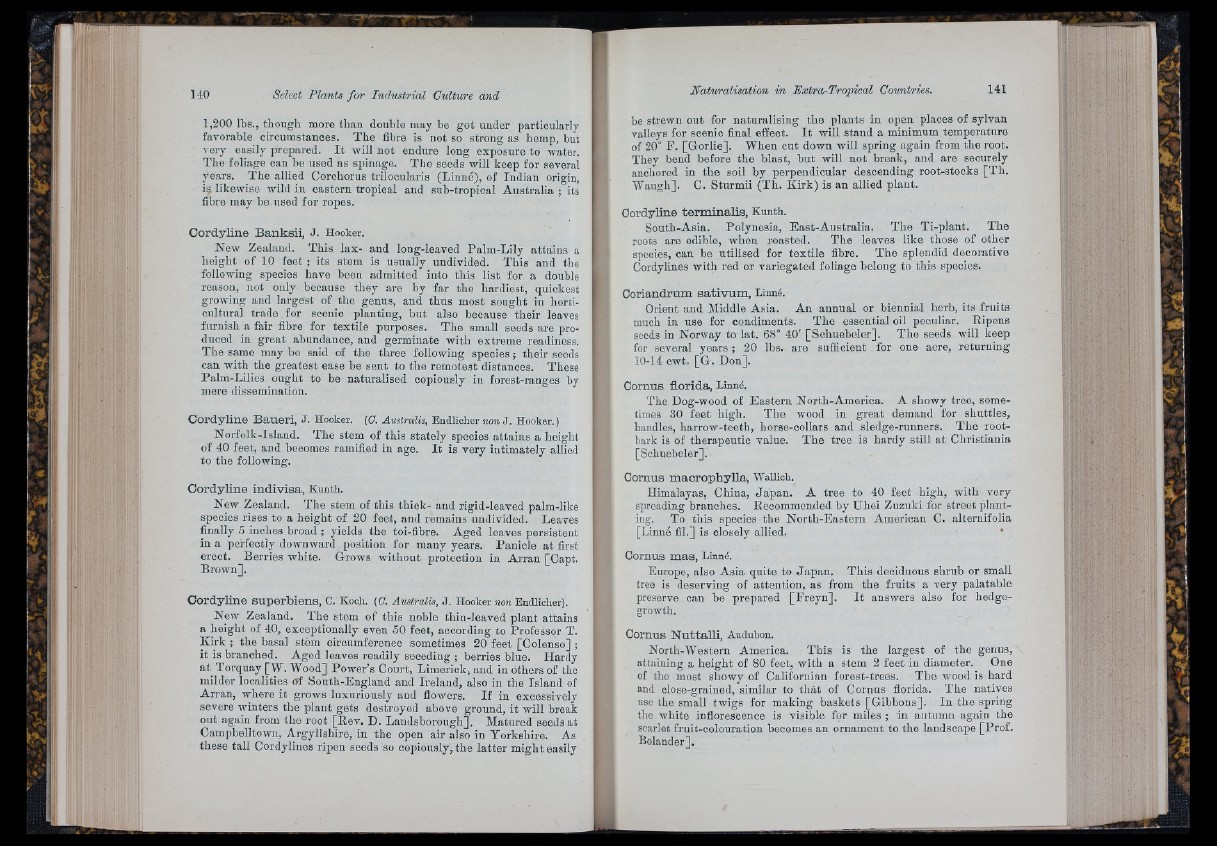
í-1 :
Ï! i
1,200 Ibs., though more than double may be got under particularly
favorable circumstances. The fibre is not so strong as hemp, but
very easily prepared. I t will not endure long exposure to water.
The foliage can be nsed as spinage. The seeds will keep for several
years. The allied Corchorus trilocularis (Linné), of Indian origin,
is likewise wild iu eastern tropical and sub-tropical Australia ; its
fibre may be.used for ropes.
C o rd y lin e B an k sii, J. Hooker.
New Zealand. This lax- and long-leaved Palm-Lily attains a
height of 10 feet ; its stem is usually undivided. This and the
following species have been admitted into this list for a double
reason, not only because they are by far the hardiest, quickest
growing and largest of the genus, and thus most sought in horticultural
trade for scenic planting, but also because their leaves
furnish a fair fibre for textile purposes. The small seeds are produced
in great abundance, aud germinate with extreme readiness.
The same may be said of the three following species ; their seeds
can with the greatest ease be sent to the remotest distances. These
Palm-Lilies ought to be naturalised copiously in forest-ranges by
mere dissemination.
C o rd y lin e B au e ri, J. Hooker. (G. Australis, Endlicher îioji J. Hooker.)
Norfolk-Island. The stem of this stately species attains a height
of 40 feet, and becomes ramified in age. I t is very intimately allied
to the following.
C o rd y lin e in d iv is a , Kunth.
New Zealand. The stem of this thick- and rigid-leaved palm-like
species rises to a height of 20 feet, and remains undivided. Leaves
finally 5 inches broad ; yields the toi-fibre. Aged leaves persistent
in a perfectly downward position for many years. Panicle a t first
erect. Berries white. Grows without protection in Arran [Capt.
Brown],
C o rd y lin e s u p e rb ie n s , 0. Kooh. (G. Australis, J. Hooker non Endlicher).
New Zealand. The stem of this noble thin-leaved plant attains
a height of 40, exceptionally even 50 feet, according to Professor T.
Kirk ; the basal stèm circumference sometimes 20 feet [Colenso] ;
it is branched. Aged leaves readily seceding ; berries blue. Hardy
a t Torquay [W. Wood] Power’s Court, Limerick, and in others of the
milder localities of South-Eugland and Ireland, also in the Island of
Arran, where it grows luxuriously and flowers. I f in excessively
severe winters the plant gets destroyed above ground, it will break
out again from the root [Bev. D. Landsborough]. Matured seeds at
Campbelltown, Argyllshire, in the open air also in Yorkshire. As
these tall Cordylines ripen seeds so copiously, the la tte r might easily
he strewn out for naturalising the plants in open places of sylvan
valleys for scenic final effect. I t will stand a minimum temperature
of 20° F. [Gorlie]. When cut down will spring again from the root.
They bend before the blast, but will not break, and are securely
anchored in the soil by perpendicular descending root-stocks [T h .
Waugh]. C. Sturmii (T h . K irk ) is an allied plant.
C o rd y lin e t e rm in a l i s , Kunth.
South-Asia. Polynesia, East-Australia. The Ti-plant. The
roots are edible, when roasted. The leaves like those of other
species, can be utilised for textile fibre. The splendid decorative
Cordylines with red or variegated foliage belong to this species.
C o r ia n d rum s a t iv u m , Linné.
Orient and Middle Asia. An annual or biennial herb, its fruits
much in use for condiments. The essential oil peculiar. Ripens
seeds in Norway to lat. 68° 40' [Schuebeler]. The seeds will keep
for several years ; 20 lbs. are sufficient for one acre, returning
10-14 cwt, [G . Don].
C o rn u s f lo r id a , Linné.
'The Dog-wood of Eastern North-America. A showy tree, sometimes
30 feet high. The wood iu great demand for shuttles,
handles, harrow-teeth, horse-collars and sledge-runners. 'The root-
bark is of therapeutic value. The tree is hardy still a t Christiania
[Schuebeler].
C o rn u s m a c r o p h y lla , Wallich.
Himalayas, China, Jap an . A tree to 40 feet high, with very
spreading branches. Recommended by Uhei Zuzuki for street planting.
To this species the North-Eastern American C. alternifolia
[Linné fil.] is closely allied. *
Co rn u s m a s , Linné.
Europe, also Asia quite to Jap an . This deciduous shrub or small
tree is deserving of attention, as from the fruits a very palatable
preserve can be prepared [Frey n ]. I t answers also for hedge-
growth.
Co rn u s N u t t a l l i , Audubon.
North-Western America. This is the largest of the genus,
attaining a height of 80 feet, with a stem 2 feet in diameter. One
of the most showy of Californian forest-trees. The wood is hard
and close-grained, similar to th a t of Cornus florida. 'The natives
use the small twigs for making baskets [Gibbons]. In the spring
the white inflorescence is visible for miles ; in autumn again the
scarlet fruit-colouration becomes an ornament to the landscape [Prof.
Bolander].